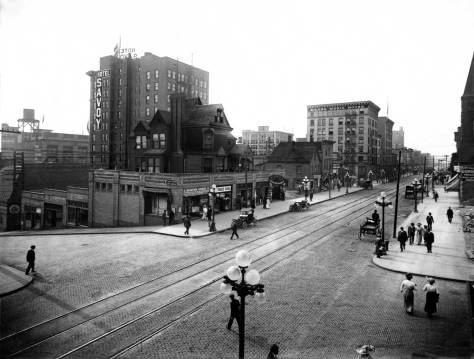(click to enlarge photos)


The arch standing here at the southeast corner of Union Street and Third Avenue was short-lived, like every other ceremonial ornament contrived for the Seattle Street Fair and Carnival, assembled and produced by the Seattle Elks Lodge for thirteen sunny days in August 1902. This arch, the only rustic one, was the odd one of four built for the fair. It was a vernacular showpiece with a somewhat exotic shape, covered overall with cedar shakes, making it regional, while wrapping it with electric lights made it modern.

The other three arches, by contrast, were all-white, reminders of the also temporary Beaux Arts architecture of Chicago’s 1893 Columbia Exposition. The two largest spanned First and Second Avenues widely enough to permit electric trolleys to pass through. With their ornamental splendor, the three classical arches were also unwitting

premonitions of Seattle’s own World’s Fair, its 1909 Alaska-Yukon-Pacific Exposition. One of the three crossed Union Street about a half-block behind – west – of the unnamed photographer. With two booths asking for the ten-cent admission, it served the fair as the main ticket gate to the fenced celebration.


The dime paid for everything that was spread about on the acres selected from the former University of Washington campus. The off-campus Third Avenue block between Union and University Streets was also lined with booths, and Union Street as well, from

the ticket booth east into the old campus that was covered with tents such as the one seen on the far right of this week’s ‘then’ photograph. And nearly everything was enveloped in strings of electric lights. The Elks promised that the grounds at night would be “almost as light as day.” Some of the exotic thrills inside the fenced tents were an “Arabian trainer in a den of lions,” a “cage of leopards,” “Jabour’s Oriental Carnival and Menageries Company,” and “a troupe of 160 Orientals, Turks, Assyrians, Egyptians, East Indians, Japanese,” in addition to “dozens of unusual things.” The Elks fair was also distinguished and promoted by daily parades through the city streets. One of the attractions was a “ladies band with eighteen pieces.”

Although exceptionally civic-minded, the Plymouth Congregational Church, on the far right at University Street, was not inside the fenced fair grounds. The Armory, the structure with the long roof half-hidden behind the arch, was. Among its many well-promoted events was a contest in the “pretty booth” with prizes for the prettiest girl and the handsomest boy and also “the largest and fattest baby 16 months old.” The judge was a local doctor who prudently fled the Armory following the contests.

WEB EXTRAS
Anything to add, lodge members? Yes Jean, and we remain faithful to your designs. Before putting forward Ron’s links we will add three more illustrations of the southeast corner of Third Ave. and Union Street: from top-to-bottom, the corner cleared, building the Post Office, the modern class-curtain post office proposed by its architects. Their rendering looks considerably better than the thing itself, however, we recall the Latin aphorism on taste (that we may have misspelled). “De gustibus non desputandum est. ” or “taste is not debatable” except that is surely is debated.
=====
=====
=====
=====
=====
=====
=====
=====
=====
=====
=====

=====
=====
STATE-WIDE ELKS
=====






























